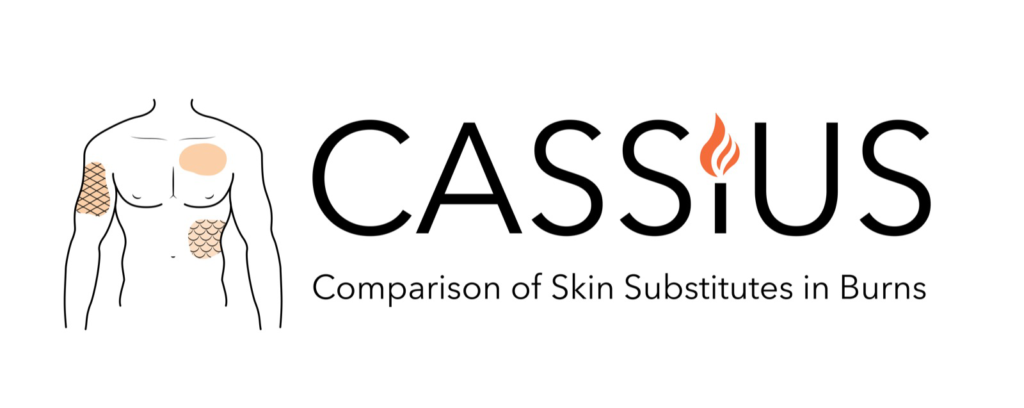
Background
Skin substitutes are a group of wound coverage materials that aid would closure and replace the functions of the skin. Many different skin substitutes are available for different indications. They can be temporary or permanent, and of biological, biosynthetic or totally synthetic origin.
Examples of skin substitute use in clinical practice include:
• Dressings for superficial partial thickness burns, e.g., biobrane®;
• Dressings for deep partial or full thickness burns e.g., xenograft;
• Dermal replacement in deep partial or full thickness burns, e.g., Integra®.
A wide range of skin substitutes are available, and choice of substitute is influenced by many factors including burn depth and location, availability of donor site, risk of infection, aesthetic outcome, cost and surgeon and patient preference. There are few randomised-controlled trials comparing skin substitutes and previous systematic reviews have been limited by the diversity of products and small participant numbers. As a result, there is a paucity of high-quality evidence to guide practice, which varies by institution.
Study Aims
The CASSIUS survey is a national survey to evaluate:
- Clinician awareness of skin substitutes and their constituents
- Clinicians’ use of skin substitutes for burn wounds of different depths, and donor site wounds
- Variation in use of skin substitutes across the UK
- Factors involved in clinician decision making for skin substitutes
The survey will be used to identify areas of clinical equipoise related to the use of skin substitutes. This will inform future clinical trial questions.
Registration
Registration to join as a collaborator on this study is open. The form can be accessed here
Please read the collaborator information sheet before you register
Collaborator Status
Only collaborators and PIs from Burns units and centres are eligible for PubMed-citable collaborator status. This is because input from Burns Consultants / SAS surgeons is essential.
To qualify, you should obtain survey responses from at least:
- 80% of Burns Consultants / SAS (you may include non-Burns Consultants if they regularly make decisions about skin substitute use)
- 5 other doctors who work in your Department (non-Burns Consultants, registrars, and senior house officers)
- 1 or more Burns nurses / practitioners
Collaborators and PIs from Burns facilities are eligible for acknowledgement only.
To qualify, you should obtain survey responses from at least:
- 10 doctors who work in your Department (Consultants, registrars and senior house officers).
Steering group decisions on collaborator status are final.

- Ian King, Consultant Plastic Surgeon, Queen Victoria Hospital
- Baljit Dheansa, Consultant Burns & Plastic Surgeon, Queen Victoria Hospital
- Declan Collins, Consultant Burns & Plastic Surgeon, Chelsea and Westminster Hospital
- Andrew McKean, Plastic Surgery Registrar, London
- Justin Wormold, Plastic Surgery Registrar, Thames Valley, NIHR Academic Clinical Fellow, Oxford
- Alice Lee, Trainee Lead for Plastic Surgery

- National Survey
- Systematic review
- Recruiting Centres
- Data Analysis
- Manuscript Submission
- Publication
Contact
FAQs
No. The survey requires familiarity with skin substitutes which is less common amongst medical students and foundation trainees.
One. If you are unsure whether someone has already registered, please ask locally or get in touch with the steering group (cassius.study@gmail.com).
Yes, provided you fulfil one of the respondent categories above and currently work in a Burns facility, unit or centre.
To improve survey returns.
Approximately 10-15 minutes for Burns Consultants/SAS surgeons and 5 minutes for other respondents.
Yes – it is still useful to know which Burns units and centres do not use skin substitutes.
Approval from the Departmental lead is required. It may be useful to share this document with them to provide more information. If they have specific queries, you can direct these to the steering group (cassius.study@gmail.com).
Try to encourage as many responses as possible, as the survey is more likely to be published with a higher number of responses. If you cannot meet the 80% target, it might be possible to compensate by increasing the responses in other categories. This must be agreed with the steering group beforehand (please email cassius.study@gmail.com).
We recommended a team approach to survey distribution with your supervising Consultant. It may be useful to share this information sheet with your colleagues and raise awareness about the study at departmental meetings. If you are low in a single category of respondents, it might be possible to compensate by increasing the responses in other categories. This must be discussed with the steering group on a case-by-case basis (cassius.study@gmail.com)
Yes, providing the above requirements for Burns units and centres are met.
The CASSIUS Survey aims to describe skin substitute use in the UK. Knowing how and when skin substitutes are used locally will help us to characterise variation across the country. Identifiable unit policies and data will never be published.
It helps us to work out a response rate for our survey, which is essential for most Journals. It also helps us work out how many responses to expect from your Department.
Unfortunately not. This is because most of the survey requires input from specialist Burns Consultants / SAS surgeons. However, collaborators from facilities will still be acknowledged if they obtain 10 survey responses from doctors in their department.
Yes. We recognise that non-Burns specialists may make decisions regarding skin substitute use. If this applies to you, please select the ‘Burns Consultant / SAS’ category in the survey.
The survey will be used to identify areas of clinical equipoise related to the use of skin substitutes. This will inform future clinical trial questions. Some of the information will also help with feasibility planning; for example, clinicians’ willingness to randomise patients and number of patients treated with skin substitutes per unit per month.
